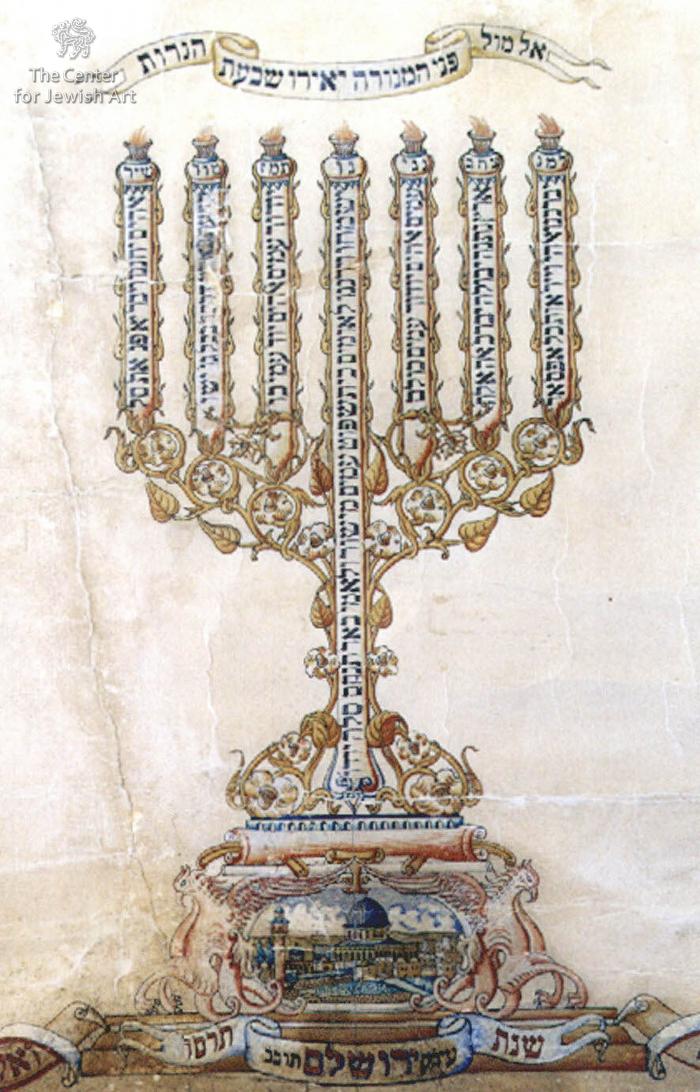Obj. ID: 48412 Shiviti, Jerusalem, 1906

sub-set tree:
The following description was prepared by William Gross:
The Shiviti plaque takes its name from a phrase in the Psalms, "Shiviti Adonai Lenegdi Tamid". "I will always hold the Lord before me." During morning prayers, the 67th Psalm is read as a part of the liturgy. The making of such visual pages to augment the reading started almost 500 years ago. It began because of a particular story or legend. The custom relates that if one gazes on the form of the Menorah while reciting the Psalm, or reads the Psalm written in the form of a Menorah, the person is carried back to the Temple, standing before the golden Temple Menorah itself. To complete the illusion, some of the Temple implements were often illustrated. The mysticism of the idea is clear, and the Shiviti page is often filled with Kabbalistic abbreviations as well as the Menorah form. Sometimes, depending on the size and complexity of the image, other texts read during the time of prayer are also presented on the sheet.
Such pages appear as small sheets to be inserted into a prayer book and taken out when the psalm is recited or as large pages to be hung on the wall of the synagogue for the viewing by the whole congregation. The sheet was also used on the wall of a home or Sukkah. Later still, the Shiviti could be printed in the prayer book or painted on the wall of the synagogue. There are numerous examples of both the prayer book tradition and the wall plaque tradition in the Gross Family Collection.
This Shiviti plaque was executed to hand in a Jerusalem synagogue, fashioned by the early Jerusalem artist Zalman Zweig. He came to Israel from Hungary as a young boy in the latter part of the 19th century. In the early and growing Jewish community in Eretz Israel from the 19th century into the 20th, Zalman Zweig was one of the few Ashkenazi Jews to attempt to make a living as an artist. He lived in Beit Ha-Hungarim, a group of buildings inhabited by Hungarian immigrants, located in the most religious section of Jerusalem. The page is very finely designed and painted from an artistic point of view. The Menorah with the 67th Psalm is at the center. At the base is a fine image of the Temple Mount, while on the pillars and arch surrounding the Menorah are inscribed amuletic formulas including the 42 letter name of God. At the bottom is a later inscription memorializing the date of the death of the artist, Zalman Zweig. He was one of the few Ashkenazim to try to make his living from being an artist in the Holy Land. Some of his works are yet in synagogues in the ultra-religious section of Jerusalem or in the hands of the families who are his descendents and still living in Jerusalem. This particular page was displayed for many years in the synagogue "Ba'ale Melacha" in the Mea She'arim neighborhood. Some 25 years later a printed version of this sheet was published by the lithographic firm of A.L. Monsohn (058.011. )
Inscription(s): The work of the hands of the Rav Reb Zalman Zwieg, the righteous, of blessed memory, who passed away the 17th of Adar 1, (5)706 [1946]



